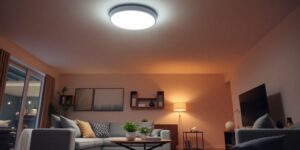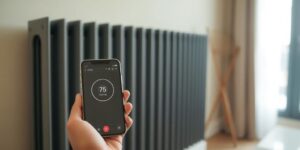In today’s world, homes are becoming smarter. However, with the multitude of available Smart Home hubs, choosing one can be a real challenge. In this article, we will discuss the most important factors you should consider when selecting your Smart Home hub. Whether you are planning a new construction project or retrofitting an older house, we will help you make the right decision.
Key Insights
- Consider the costs, both for the purchase and any potential monthly fees.
- Ensure that the hub is compatible with your existing devices.
- Choose a system that is flexible and expandable in case you want to add more devices in the future.
- Decide whether a centralized or decentralized system better suits your needs.
- Think about security and privacy to protect your personal data.
Important Factors When Choosing
Of course, before you decide on a Smart Home system, there are a few things you should check. Otherwise, you might end up buying something that doesn’t fit your needs. It’s like buying a car – it has to fit your life, right?
Costs
Okay, money definitely plays a role. Think about what you want and can spend. Not just for the purchase, but also for ongoing costs. Some providers charge a monthly fee for their services. And that can add up.
Compatibility With Existing Devices
Do you already have smart devices at home? Then check carefully if they are compatible with the new system. Not every system works with every device. Imagine buying a new remote that can’t control your TV – total bummer, right?
Scalability And Expansion Options
Even if you are starting with just a few smart bulbs, you might want more later. Make sure that you can easily expand the system. Otherwise, you might find yourself having to buy everything new later. And nobody wants that.
Remember: A good Smart Home system is like a building block set. You start small and then expand it as needed. This way, you stay flexible and don’t waste money unnecessarily.
The Most Popular Smart Home Systems
Okay, now it gets exciting! Let’s take a look at the most popular Smart Home systems out there. There are quite a few, and each has its pros and cons. Which system is best for you depends entirely on what you expect from your Smart Home and which devices you already have.
Amazon Alexa
Alexa is super well-known because it is so easy to use. You can just talk to Alexa, and she does what you want. This is really handy when you don’t have a hand free. Plus, there are tons of devices that work with Alexa, from lights to vacuum cleaners. Another plus is that Alexa supports voice control, making operation even easier. However, you should be aware that Amazon also collects data.
Google Home
Google Home is similar to Alexa, but here the Google Assistant is in the spotlight. The Google Assistant is really smart and can help you with many things, not just in the Smart Home. Google Home is also good at adapting to your habits and making personalized suggestions. Additionally, Google Home works great with other Google services, like Google Calendar or Google Maps. But again, Google collects data.
Apple Home
If you have an iPhone or other Apple devices, Apple Home might be the right choice for you. Apple places a lot of emphasis on privacy, which is an important point for many people. With Apple Home, you can also control your devices with Siri. However, the selection of devices that work with Apple Home is somewhat smaller than with Alexa or Google Home. On the other hand, the integration into the Apple ecosystem is very good.
Remember that all these systems have their strengths and weaknesses. It’s important to consider what matters most to you: ease of use, a large selection of devices, privacy, or integration into a specific ecosystem. Then you can choose the system that best fits your needs.
Radio Standards And Their Advantages
Hey, let’s talk about the different radio standards that keep your Smart Home running. There are a few important differences you should know before deciding on a system.
WLAN
You probably already know WLAN from your router. It’s super convenient because almost every device can use WLAN. But beware: Many WLAN devices can really overload your network. This can lead to problems when you use many devices simultaneously. Additionally, power consumption is often higher than with other standards.
Zigbee/Z-Wave
Zigbee and Z-Wave were specifically developed for Smart Homes. They consume much less power than WLAN and create a so-called mesh network. This means that the devices communicate with each other, thus increasing the range. Imagine each device as a little radio bridge. Z-Wave usually operates on a different frequency than your WLAN, which can reduce interference. Zigbee is a bit more flexible in that regard.
Matter
Matter is the new star in the Smart Home sky. It aims to unify the various standards and ensure that devices from different manufacturers work together seamlessly. This is especially cool because you won’t be so tied to a specific ecosystem anymore. Matter relies on various radio standards like WLAN, Thread, and Bluetooth. Thread is a radio standard similar to Zigbee, but with the advantage of being particularly resilient. If one device fails, another can take over its function.
The future of Smart Home technology heavily depends on the development and establishment of universally recognized standards that prioritize seamlessness and user orientation. This will create an ecosystem that is not only innovative and secure but also allows for easy integration into everyday life.
Centralized And Decentralized Systems
Okay, now it gets a bit technical, but don’t worry, we’ll keep it simple. Imagine your Smart Home as a small city. There are different ways to manage this city: centralized or decentralized.
Pros And Cons Of Centralized Systems
In a centralized system, you have a kind of town hall that controls everything. That’s your Smart Home hub. All devices report to it, and the hub tells them what to do.
- Advantages: Super easy control, everything in one place. You can create complex automations because the hub has the overview. These systems are often more reliable because communication is clearly regulated.
- Disadvantages: If the hub fails, your entire Smart Home comes to a standstill. Additionally, you are heavily dependent on that one manufacturer. Expanding with devices from other manufacturers is often difficult or impossible. The Ethernet connection is very important here.
Flexibility Of Decentralized Systems
A decentralized system is more like a shared apartment. Each device is a bit smarter and can communicate directly with other devices without a central authority managing everything.
- Advantages: If one device fails, the others keep running. You have more flexibility in choosing devices because not everything has to be from one manufacturer. The system is often more robust against disturbances.
- Disadvantages: Setting up and configuring can be more complicated. It requires more technical understanding to get everything running. Compatibility between different devices needs to be checked carefully. Security is another aspect that requires more attention in open systems, as networking multiple different products can potentially create more points of attack.
Imagine you have a centralized system and the hub breaks down. Suddenly, you can’t turn on the lights, control the heating, and the alarm system is useless. With a decentralized system, at least some functions would still be operational.
Use Cases
Which system is better depends entirely on what you plan to do. For a small apartment where you mainly want to control lights and heating, a centralized system might be sufficient. However, if you have a large house and want to use many different devices from various manufacturers, a decentralized system is probably the better choice. Or maybe a hybrid solution that combines the advantages of both worlds? The decision is yours!
Getting Started In The Smart Home World

Sure, Smart Home sounds like something from the future, but actually, it’s super easy to get started. You don’t have to be a tech guru, promise! It’s about making your home smarter so that you can be more comfortable and maybe even save a bit of energy. Let’s take a look at how to get started.
Define Your Needs
Before you start buying things wildly, ask yourself: What do you want to achieve? Do you want to save energy? Or is it more about comfort? Maybe also about security? Make a list of what is important to you. Here are a few questions that can help:
- Where are the pain points right now? What annoys you in everyday life?
- What would you like to automate?
- What devices do you already have, and how could they become smarter?
Choose The Right Ecosystem
Okay, now it gets a bit more technical, but no panic! An “ecosystem” is just the family of devices that work well together. Think of Apple, Google, or Amazon. They all have their own Smart Home systems. Here are a few tips:
- If you’re already an Apple fan, Apple HomeKit is probably the best choice.
- If you want it super simple, Amazon Alexa or Google Home are great.
- And if you want to know everything and set everything up yourself, check out Home Assistant.
Important: Make sure that the devices you buy are compatible with your chosen ecosystem. Otherwise, it will be frustrating.
Step-By-Step Expansion
You don’t have to buy everything at once! Start small, for example, with a smart light bulb or a smart plug. If that goes well, you can always buy more later. Here are a few ideas to get started:
- Smart lighting in the living room
- A smart thermostat in the bathroom
- A smart speaker with voice control
And remember: It’s your home, so do it the way you like! Have fun experimenting!
Security And Privacy In The Smart Home
Sure, a smart home is super convenient, but remember: Security and privacy are really important! Otherwise, you open the door wide for hackers. Here are a few things to pay attention to:
Security Features
- Strong Passwords: Use a secure password for each device and app. Don’t just use “123456” or your birth date!
- Two-Factor Authentication: Enable this feature wherever possible. It makes it much harder for hackers to break into your system.
- Regular Updates: Keep your devices and apps up to date. Updates often close security gaps.
- Firewall: A good firewall protects your network from external attacks.
Privacy Options
- Data Encryption: Ensure that your devices and apps encrypt your data. This way, it can’t be easily intercepted.
- Privacy Policies: Read the privacy policies of the manufacturers carefully. What happens to your data? Who has access to it?
- Data Minimization: Only share as much data as necessary. Do you really need to share your entire daily routine with your smart fridge?
- Local Control: Devices that are controlled locally are often more secure than cloud-based systems, as less data is exposed.
Minimizing Risks
- Secure Devices: Change the default passwords of your devices immediately after installation. Many devices have preset passwords that are easy to crack.
- Network Segmentation: Divide your network into different areas. This way, if hackers break into one area, they can’t easily access all devices.
- Use VPN: A VPN secure network can encrypt your connection and hide your IP address.
- Monitoring: Keep an eye on your devices and your network. Are there any suspicious activities?
Remember: A smart home is only as secure as the weakest link in the chain. Take security and privacy seriously so you can enjoy your smart home worry-free!
Smart Home For New Builds And Old Buildings

Sure, a Smart Home is super convenient, whether you’re building new or have been living in your place for a while. But there are some differences to pay attention to.
Planning In New Builds
If you are currently building a house, you have the advantage of being able to plan everything smartly from the start. This can save you a lot of hassle and money later! Think about:
- Conduits for cables (even if you are starting with wireless, who knows what the future holds?).
- The positioning of outlets (where do you need power for smart devices?).
- The choice of radio standards (WLAN, Zigbee, Z-Wave, Matter – what fits your needs?).
Imagine forgetting all this and having to break down walls later to run cables. No fun, believe me!
Retrofitting In Old Buildings
No new build? No problem! You can also make your home smart in an old building. Here are a few things to consider:
- WLAN coverage: Is your WLAN good everywhere? Otherwise, you might need repeaters.
- Radio standards: Not all devices are compatible with all standards. Check this beforehand!
- Building substance: Thick walls can interfere with radio signals.
Tips For Old Building Owners
- Use radio standards like Zigbee or Z-Wave: They are often better than WLAN when it comes to range and energy efficiency.
- Don’t forget about privacy: Smart devices collect data. Inform yourself about how your data is protected.
- Think about Smart Home devices: Which devices really make your life easier? Start with those.
Conclusion: Find The Perfect Smart Home System For You!
So, now you know what to look for when it comes to Smart Home systems. There are really many options, and the right one for you depends on your needs. Think about the costs, compatibility with your devices, and how easy everything is to use. And don’t worry, you don’t have to buy everything at once. Start small and expand step by step. Whether you’re a tech enthusiast or just want to make your home smarter, there’s a suitable system for everyone. Get ready to bring your home into the future!
Frequently Asked Questions
What are the most important factors when choosing a Smart Home system?
The costs, compatibility with existing devices, and the ability to expand the system later are crucial.
How much does a Smart Home system cost?
Costs can vary widely. You should consider both the purchase costs and any potential monthly fees.
Can I expand my existing Smart Home system?
Yes, many systems are designed to allow you to add new devices gradually.
Are all Smart Home devices compatible with each other?
Not all devices are compatible with every system. It’s important to check this before purchasing.
How secure are Smart Home systems?
Security varies depending on the system. Look for strong security features and privacy options.
Can I install a Smart Home in an old building?
Yes, there are solutions that can be easily retrofitted in old buildings.



